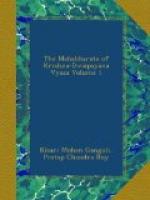and then of Ghatotkacha. Then, must you know,
comes the story of the death of Drona of surprising
interest. The next that comes is called the discharge
of the weapon called Narayana. Then, you know,
is Karna, and then Salya. Then comes the immersion
in the lake, and then the encounter (between Bhima
and Duryodhana) with clubs. Then comes Saraswata,
and then the descriptions of holy shrines, and then
genealogies. Then comes Sauptika describing incidents
disgraceful (to the honour of the Kurus). Then
comes the ‘Aisika’ of harrowing incidents.
Then comes ‘Jalapradana’ oblations of
water to the manes of the deceased, and then the wailings
of the women. The next must be known as ‘Sraddha’
describing the funeral rites performed for the slain
Kauravas. Then comes the destruction of the Rakshasa
Charvaka who had assumed the disguise of a Brahmana
(for deceiving Yudhishthira). Then the coronation
of the wise Yudhishthira. The next is called
the ‘Grihapravibhaga’. Then comes
‘Santi’, then ‘Rajadharmanusasana’,
then ‘Apaddharma’, then ‘Mokshadharma’.
Those that follow are called respectively ‘Suka-prasna-abhigamana’,
‘Brahma-prasnanusana’, the origin of ‘Durvasa’,
the disputations with Maya. The next is to be
known as ‘Anusasanika’. Then the ascension
of Bhishma to heaven. Then the horse-sacrifice,
which when read purgeth all sins away. The next
must be known as the ‘Anugita’ in which
are words of spiritual philosophy. Those that
follow are called ‘Asramvasa’, ‘Puttradarshana’
(meeting with the spirits of the deceased sons), and
the arrival of Narada. The next is called ‘Mausala’
which abounds with terrible and cruel incidents.
Then comes ‘Mahaprasthanika’ and ascension
to heaven. Then comes the Purana which is called
Khilvansa. In this last are contained ‘Vishnuparva’,
Vishnu’s frolics and feats as a child, the destruction
of ‘Kansa’, and lastly, the very wonderful
‘Bhavishyaparva’ (in which there are prophecies
regarding the future).
The high-souled Vyasa composed these hundred parvas
of which the above is only an abridgement: having
distributed them into eighteen, the son of Suta recited
them consecutively in the forest of Naimisha as follows:
’In the Adi parva are contained Paushya, Pauloma,
Astika, Adivansavatara, Samva, the burning of the
house of lac, the slaying of Hidimba, the destruction
of the Asura Vaka, Chitraratha, the Swayamvara of Draupadi,
her marriage after the overthrow of rivals in war,
the arrival of Vidura, the restoration, Arjuna’s
exile, the abduction of Subhadra, the gift and receipt
of the marriage dower, the burning of the Khandava
forest, and the meeting with (the Asura-architect)
Maya. The Paushya parva treats of the greatness
of Utanka, and the Pauloma, of the sons of Bhrigu.
The Astika describes the birth of Garuda and of the
Nagas (snakes), the churning of the ocean, the incidents
relating to the birth of the celestial steed Uchchaihsrava,
and finally, the dynasty of Bharata, as described




